|
|
|
Sort Order |
|
|
|
Items / Page
|
|
|
|
|
|
|
| Srl | Item |
| 1 |
ID:
176905


|
|
|
|
|
| Summary/Abstract |
Achieving grid parity of solar photovoltaic (PV) power in China has great implication for the future energy system transformation. In this work whether and when, and under what conditions the grid parity can be achieved are assessed, and especially the role of Tradable Green Certificate (TGC) policy in achieving the grid parity is explored. We first estimate the future levelized cost of electricity (LCOE) of solar PV power using learning curve method, and then by comparing it with on-grid price of coal-fired power, the grid parity of solar PV power is determined. Specifically, using a panel dataset consisting of information of 541 solar PV power projects over the period of 2010–2016, the learning rate of PV power is estimated, based on which the future LCOEs are estimated. The results show that the LCOE of PV power decreases from 0.4631 CNY/kWh in 2018 to 0.3345 CNY/kWh in 2030 under the baseline scenario of the cumulative installed capacity, and the grid-parity of solar PV power may be achieved between 2023 and 2025. With the TGC policy being implemented, the grid parity can be achieved earlier. Specifically, with the TGCs price reaching 100 CNY, the grid parity can be achieved in 2020.
|
|
|
|
|
|
|
|
|
|
|
|
|
|
|
|
| 2 |
ID:
176892
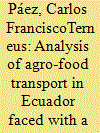

|
|
|
|
|
| Summary/Abstract |
The objective of this article is to analyze the food transport in Ecuador faced with a possible reduction in the subsidy of diesel, taking as a case study the Metropolitan Public Company Wholesale Marketplace of Quito, in order to identify guidelines for the formulation of strategies in the event of a reduction in the subsidy of this fuel. A bottom-up methodology is applied, which uses a survey as a tool, as well as secondary information generated by the state organizations. It is concluded that this investigation identifies the agro-food transport sector of the Wholesale Market. The median fuel consumption and energy intensity, of trucks that arrive with products at the Quito Wholesale Market, are 31 (l/100 km) and 15 (l/100tkm), respectively. The median percentage of the cost of fuel, with respect to the price of the product, is 1.2%. Meanwhile, assuming that the fuel subsidy was eliminated, and the price of diesel came to cost $ 2.27 USD/gallon; the median percentage of price increase in the product would be 1.6%. However, the low regulation on the sector makes the cost of agri-food more susceptible to a decrease in the subsidy.
|
|
|
|
|
|
|
|
|
|
|
|
|
|
|
|
| 3 |
ID:
176862
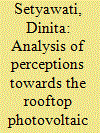

|
|
|
|
|
| Summary/Abstract |
In 2018, the Indonesian government issued the Rooftop Photovoltaic Solar Systems (RPVSS) policy that allows customers of the State Electricity Company (PLN) to generate their own electricity supply from solar photovoltaic (PV) systems and export surplus electricity to the national grid, valued at 65% of the full retail tariff. This policy is an effort to increase renewable energy levels in the national energy mix by 23% by 2025. Customer adoption of PV systems relies on the perceptions and perceived benefits of the technology, as well as general issues of confidence in the product. This paper explores the public's acceptance of the RPVSS policy from multiple perspectives. An online survey of PLN customers (n = 987) indicated consumer issues in adopting PV systems, such as high capital costs, long term return on investment and lack of information, as well as institutional issues such as the limited role of PLN and the absence of government financing mechanisms. Additional interviews with the government, private sector and energy experts identify the export rate for electricity injected into the grid as the main barrier to attracting prospective users. This paper's findings provide useful recommendations for policymakers to successfully implement the policy and increase solar energy deployment.
|
|
|
|
|
|
|
|
|
|
|
|
|
|
|
|
| 4 |
ID:
176863
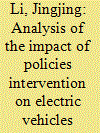

|
|
|
|
|
| Summary/Abstract |
Electric vehicles (EVs), which can relieve the pressure of energy and environment and revitalize the automotive industry, are paid great attention by the government. Existing research on the dynamic adoption process of EVs from the perspective of consumers based on complex social networks is insufficient. Based on the consumer network with dual attributes, i.e., positive/negative attitude and whether or not to adopt, this paper explores the impact of economic and information policies on EVs adoption rate by establishing a decision-making model of EVs adoption for consumers considering the effects of friend attitudes and power consumption information. The results show that: (1) The joint implementation of economic policies has a prominent effect on the adoption rate of EVs that is least affected by the subsidy cut policy when charging at home. (2) Enhancing popular science propaganda promotes the EVs adoption rate by increasing the initial proportion of positive attitudes in the consumer network. However, the promotion effect will be weakened if it exceeds a certain threshold. (3) Encouraging social discussion by expanding the number of friends has two sides to the EVs adoption rate. Finally, policymakers should consider the impact of consumers with different risk preferences on EVs adoption.
|
|
|
|
|
|
|
|
|
|
|
|
|
|
|
|
| 5 |
ID:
176834
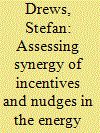

|
|
|
|
|
| Summary/Abstract |
Should policy-makers combine price incentives with behavioural nudges to encourage sustainable energy behaviour? Available evidence from various behavioural sciences is scarce and inconclusive about synergy of the two instruments. This is partly due to methodological limitations. We offer a framework to overcome such limitations in future research and to guide policy-making. It includes four cases: no synergy, positive synergy, weak negative synergy, and strong negative synergy or backfire. The adoption of a policy mix is recommended in the first two cases, and may be pursued in the third case. To clarify the underlying mechanisms of the synergy, a distinction is made between crowding (in/out) of intrinsic motivations by incentives and crowding (in/out) of extrinsic motivations by nudges. This distinction turns out to be especially relevant in the case of weakly negative synergy, as here behavioural and temporal spillover effects require consideration from the policy-maker as well. We end with broader reflections regarding other policy criteria for the design of an adequate energy policy mix.
|
|
|
|
|
|
|
|
|
|
|
|
|
|
|
|
| 6 |
ID:
176889
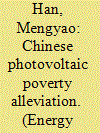

|
|
|
|
|
| Summary/Abstract |
As a part of an environmentally concerned development strategy, the photovoltaic poverty alleviation in China is adopted to lift households above the rural extreme poverty line by the end of 2020. With the detailed project-level data in 534 counties, 22 provinces, this systematic assessment on Chinese photovoltaic power projects identifies geographic distribution, economic benefits and emission mitigation for deployment distribution and policy implications. Overall, the photovoltaic installed capacity has reached 5213.37 MW, with the income generation of 7.41 billion CNY per year and the carbon emission mitigation of 5.98 million tons. From the results in this work, it is obvious that the GDP and household savings per capita in most counties and cities are lower than in those without photovoltaic poverty alleviation stations. As an essential strategy of generating income and mitigating emissions especially in countries well-endowed with sunlight, the deployment of photovoltaic power projects is consistent with sustainable development goals relating to global poverty eradication. With the assessments on the photovoltaic power stations, the initial implementation of photovoltaic poverty alleviation revealed a number of problems and solutions, which are practical for systematic deployment and policy implications of relevant photovoltaic power projects worldwide.
|
|
|
|
|
|
|
|
|
|
|
|
|
|
|
|
| 7 |
ID:
176896
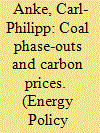

|
|
|
|
|
| Summary/Abstract |
The European Union Emission Trading System (EU ETS) constitutes the core instrument of the European Union climate protection policy. It limits greenhouse gas emissions of its member states and aims at facilitating an efficient allocation of emission reduction across national borders. Accompanying this policy at the European level, individual member states have introduced national mitigation policies, including renewable energy (RES) expansion measures or coal phase-outs.
|
|
|
|
|
|
|
|
|
|
|
|
|
|
|
|
| 8 |
ID:
176897


|
|
|
|
|
| Summary/Abstract |
Integration of conventional energy production with the Polish mining industry is a complex task in the light of decarbonisation guidelines and the development of Renewable Energy Sources. Smog as a seasonal phenomenon requires differentiation between the use of coal as fuel in conventional power plants and combined heat and power plants, and the burning of coal in the municipal and individual household sector. Domestic coal is a strategic fuel in energy and heat generation. The household sector, being the main cause of smog, is the sector that most needs to be changed. The main goal of the paper is to analyse the transition from fossil fuel combustion in households to electric heating, taking into account boiler efficiency and the current market prices of both coal and electric energy. Based on the performed calculations, we propose providing consumers with regular support in the form of electricity price subsidies (as a subsidy to the spread between the price of electricity and coal) when they decide to abandon coal and switch to electric (or district) heating, thus reducing smog. The simulation results may help in deciding on the subsidy level for both energy costs and total costs.
|
|
|
|
|
|
|
|
|
|
|
|
|
|
|
|
| 9 |
ID:
176836


|
|
|
|
|
| Summary/Abstract |
In order to effectively curb the rapidly-increasing energy consumption in manufacturing industry, China has clearly stated in Made in China 2025, to reduce energy consumption per unit of industrial added value of the manufacturing by 18% in 2020 and 34% in 2025 relative to the 2015 level. Based on the ZSG-DEA and CAT models, this paper attempts to establish an efficiency-oriented energy-consuming right trading system (ECRTS) to design the energy allocation scheme along with the energy trading scheme for China’s 18 manufacturing sectors in 2020 and 2025. We find sectors with the allocated energy-consuming right could not only reach the DEA efficiency frontier, but also upgrade their energy-consuming mix. Further, the allocation scheme considering the sectoral heterogeneity is more rational as it relieves the pressure on some sectors to conserve energy. Finally, by integrating energy offsetting mechanism into the united energy market, the energy trading mechanism designed in this work can largely simplify the transaction process and improve the after-trading efficiency for all target sectors.
|
|
|
|
|
|
|
|
|
|
|
|
|
|
|
|
| 10 |
ID:
176877


|
|
|
|
|
| Summary/Abstract |
Smart home technologies refer to devices that provide some degree of digitally connected or enhanced services to occupants. Smart homes have become central in recent technology and policy discussions about energy efficiency, climate change, and innovation. However, many studies are speculative, lacking empirical data, and focus on costs and benefits, but not business models and emerging markets. To address these gaps, our study presents data from semi-structured expert interviews and a review of the recent literature. Although we draw from empirical data collected in the United Kingdom, we place our findings in the context of Europe because the UK has access to European markets for smart home technologies and platforms. Our sampling strategy included experts from Amazon, Microsoft, the International Energy Agency, government, academic, and civil society stakeholders. We identify a diversity of definitions associated with smart home technologies and draw from our data to discuss applications centred on digital connections, enhanced control, automation, and learning. We analyse fifteen distinct business models for smart home technologies, ranging from energy services and household data monitoring to assisted living, security and safety, and new advertising channels (among others). Our assessment ought to guide future innovation patterns, technology deployment, and policy activity relating to smart homes, especially insofar as they can deliver energy services more affordably or help meeting carbon mitigation priorities.
|
|
|
|
|
|
|
|
|
|
|
|
|
|
|
|
| 11 |
ID:
176852


|
|
|
|
|
| Summary/Abstract |
Renewable Portfolio Standards (RPS) is a mandatory institutional change to realize the low-carbon transformation of energy in China. The success of its implementation depends on the scientific system design. Based on the current situation of the green certificate transaction with the severe shortage of tradable green certificate (TGC) subscription on the demand side of RPS in China and the actual economic situation of the electricity market reform, this paper uses system dynamics to build the market transaction models of benchmark on-grid price and marketed on-grid price respectively, and analyze the incentive effect of the relevant system design of RPS on the demand side of TGC. The results show that: (1) Implementing the marketed on-grid price can effectively stimulate and induce coal power plants to conduct green certificate trading. Compared with benchmark on-grid price, under marketed on-grid price, coal power plants have higher demand for TGC, higher revenue and profit, and better incentive effect. (2)Setting a scientific and reasonable price cap of TGC can effectively stimulate coal power plants to increase the consumption demand of TGC. Therefore, scientific design of the demand-side incentive system of RPS and strengthening of the power market reform will help China to implement the RPS and promote the consumption and utilization of renewable energy.
|
|
|
|
|
|
|
|
|
|
|
|
|
|
|
|
| 12 |
ID:
176832


|
|
|
| 13 |
ID:
176842


|
|
|
|
|
| Summary/Abstract |
Energy sector policies have focused historically on the planning, design and construction of energy infrastructures, while typically overlooking the processes required for the management of their end-of-life, and particularly their decommissioning. However, decommissioning of existing and future energy infrastructures is constrained by a plethora of technical, economic, social and environmental challenges that must be understood and addressed if such infrastructures are to make a net-positive contribution over their whole life. Here, we introduce the magnitude and variety of these challenges to raise awareness and stimulate debate on the development of reasonable policies for current and future decommissioning projects. Focusing on power plants, the paper provides the foundations for the interdisciplinary thinking required to deliver an integrated decommissioning policy that incorporates circular economy principles to maximise value throughout the lifecycle of energy infrastructures. We conclude by suggesting new research paths that will promote more sustainable management of energy infrastructures at the end of their life.
|
|
|
|
|
|
|
|
|
|
|
|
|
|
|
|
| 14 |
ID:
176911


|
|
|
|
|
| Summary/Abstract |
Digital platforms increasingly propose business models that improve economic organisation -by better coordinating supply and demand under imperfect information- and attain higher efficiency levels. At the same time, the energy generation gradually reshapes into decentralised network with lower capacity, but able to manage demand and supply in real-time. However, the penetration of online platforms within the energy sector poses policy questions that are specific to platforms' business models. This study investigates a sample of 217 digital platforms running energy-related activities across the EU regional markets. These energy platforms make about 20% of the world energy platforms. By observing their characteristics and those of their surrounding markets, it appears that the digital platforms in the European energy sector still tend to be relatively small and concentrated in specific regions, often in the neighbourhood of capital cities. Furthermore, the quantitative analysis suggests that market size, digital readiness and regulatory quality are the most important features relating to platforms' presence in the EU regional markets. This paper offers empirical evidence and reflections to provide energy policy with key information to best ripe the potential of new technologies while being aware of their inherited complexities.
|
|
|
|
|
|
|
|
|
|
|
|
|
|
|
|
| 15 |
ID:
176856
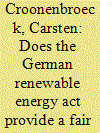

|
|
|
|
|
| Summary/Abstract |
We assess the German renewable energy incentive system for onshore wind power installations and provide a spatial profitability analysis for any given point in Germany. As it turns out, the system seems to favor certain types of facilities, dependent on the wind conditions at the site. We therefore narrow the focus down and analyze a limited set of locations selected at random. Here, we use a simulation analysis to assess the sensitivity of profitability on wind speeds, hub heights, and turbine types. Results show that increasing hub heights are not generally increasingly profitable — on the contrary, the German incentive system rather tends to favor lower hub heights. Also, the selected turbine type still has its impact on profitability — not at a great magnitude, but nevertheless gaugeable. In conclusion, the German renewable energy support system might be somewhat off target, as it possesses possibly unwanted side effects of which policy makers may not be aware.
|
|
|
|
|
|
|
|
|
|
|
|
|
|
|
|
| 16 |
ID:
176859
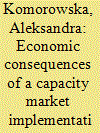

|
|
|
|
|
| Summary/Abstract |
This paper investigates the potential economic consequences of setting up a capacity market in Poland. A computable model of the Polish power generation system is developed and employed to analyse the impact of this mechanism. Two scenarios are designed for this study: (i) a reference scenario that reflects the energy-only market and (ii) a capacity market scenario that assumes the implementation of such an instrument. To assess the economic consequences, the following parameters are estimated: (i) annual electricity prices, (ii) Loss Of Load Hours, (iii) Expected Energy Not Served, and only for the capacity market scenario: (iv) market clearing price, (v) total budget of the capacity market, and (vi) increase in electricity price due to the introduction of the capacity market. The findings of the study indicate that the long-term maintenance of the energy-only market results in higher electricity prices when compared to putting a capacity market into operation. Introducing a capacity market enables existing resources to be used effectively without excessive capital expenditure. The methods and conclusions presented in this paper provide valuable findings and policy insights regarding the potential economic consequences of a capacity mechanism in a power system mostly dominated by coal and undergoing an energy transition.
|
|
|
|
|
|
|
|
|
|
|
|
|
|
|
|
| 17 |
ID:
176853


|
|
|
|
|
| Summary/Abstract |
In this paper, we estimate volatility spillovers before and after the introduction of a new cable linking different electricity market zones. Using wholesale electricity prices for Sardinia and two neighbouring Italian market zones for the period 2005–2015, we focus on the effects of the SAPEI cable, fully operational since March 2011. VAR-GARCH estimates indicate that the SAPEI cable allowed for stronger volatility transmission towards Sardinia, a smaller zone and a net importer from its new neighbour, the Central Southern zone, albeit the effect was significant only off-peak. Higher conditional correlations between zonal prices are also observed after the cable was introduced. Some implications are drawn about the interaction between market size, export positions, congestion, and volatility transmission.
|
|
|
|
|
|
|
|
|
|
|
|
|
|
|
|
| 18 |
ID:
176883
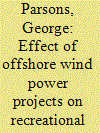

|
|
|
|
|
| Summary/Abstract |
We use contingent-behavior data from a stated-preference survey to estimate the effect of offshore wind power projects on recreational beach use on the East Coast of the United States. The data are from an internet-based probabilistic sample of beachgoers (n = 1725) visiting beaches from Massachusetts to South Carolina in 2015. The contingent-behavior data are based on responses to visual simulations of wind power projects at seven different distances offshore (2.5–20 miles) in clear and hazy conditions and at night. We consider the effect on beach enjoyment/experienceand trips taken to a beach. As expected the nearer the projects are to shore, the greater their negative effect. For example, at 2.5-miles offshore, 29% of the sample state they would not visit the beach compared to only 5% at 20-miles offshore. Offsetting the negative effects, we also find evidence of potentially a large numbers of curiosity trips to view offshore wind power projects.
|
|
|
|
|
|
|
|
|
|
|
|
|
|
|
|
| 19 |
ID:
176898


|
|
|
|
|
| Summary/Abstract |
CO2 emissions embodied in international trade have drawn wide attention in the academia and national climate negotiations. In this study, we estimate the embodied CO2 emissions in the trade between China and Australia using long time series disaggregated sectoral data based on missions embodied in bilateral trade (EEBT) method, and analyse the major driving forces for these emissions changes based on structural decomposition analysis (SDA) method. The results show that export volume contributed to these embodied CO2 emissions increase, while emission intensity could offset these CO2 emissions increase. We further predict embodied CO2 emission in Sino-Australia trade under different scenarios and the results indicate that technology spillover can significantly reduce embodied CO2 emissions in trade. Electricity, transportation and cement industries have significant potential to reduce carbon emissions. In addition, we evaluate future carbon reduction potential till 2030. The results in this study can inform decision-makers for Australia and China to formulate energy conservation and emission reduction policies.
|
|
|
|
|
|
|
|
|
|
|
|
|
|
|
|
| 20 |
ID:
176878


|
|
|
|
|
| Summary/Abstract |
Nuclear power plants in operation usually take public communication measures to increase the public acceptance of nuclear energy. This study explores how public communication affects public acceptance. The data were obtained through questionnaire surveys (N = 364) of residents living around the Qinshan, Tianwan, and Hongyanhe nuclear power plants in China. Based on the researches of mass communication effect path, a structural equation model showed that public communication cannot affect public acceptance directly, but can indirectly affect public acceptance through three paths. In the first path, public communication positively affects trust, trust positively affects perceived benefit, and perceived benefit positively affects public acceptance. In the second path, public communication positively affects trust, trust negatively affects perceived risk, and perceived risk negatively affects public acceptance. In the third path, public communication positively affects perceived benefit, and perceived benefit positively affects public acceptance. Furthermore, public communication has a positive effect on knowledge, but has no effect on public risk. This study also showed that knowledge cannot affect perceived risk and perceived benefit. We proposed policy suggestions based on the results.
|
|
|
|
|
|
|
|
|
|
|
|
|
|
|
|
|
|
|
|
|